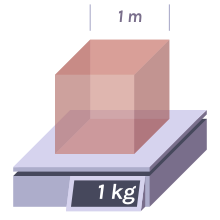The kilogram per cubic metre (symbol: kg·m−3, or kg/m3) is the unit of density in the International System of Units (SI). It is defined by dividing the SI unit of mass, the kilogram, by the SI unit of volume, the cubic metre.[1]
| Kilogram per cubic metre | |
|---|---|
 Density of the cube: 1 kg/m3 | |
| General information | |
| Unit system | SI |
| Unit of | Density |
| Symbol | kg/m3 |
| Conversions | |
| 1 kg/m3 in ... | ... is equal to ... |
| Imperial and US Customary units | 0.06242796 lb/cu ft |
| CGS units | 0.001 g/cm3 |
| MTS units | 0.001 t/m3 |
Conversions
edit- 1 kg/m3 = 1 g/L (exactly)[2]
- 1 kg/m3 = 0.001 g/cm3 (exactly)[3]
- 1 kg/m3 ≈ 0.06243 lb/ft3 (approximately)
- 1 kg/m3 ≈ 0.1335 oz/US gal (approximately)
- 1 kg/m3 ≈ 0.1604 oz/imp gal (approximately)
- 1 g/cm3 = 1000 kg/m3 (exactly)
- 1 lb/ft3 ≈ 16.02 kg/m3 (approximately)
- 1 oz/(US gal) ≈ 7.489 kg/m3 (approximately)
- 1 oz/(imp gal) ≈ 6.236 kg/m3 (approximately)
Relation to other measures
editThe density of water is about 1000 kg/m3 or 1 g/cm3, because the size of the gram was originally based on the mass of a cubic centimetre of water.
In chemistry, g/cm3 is more commonly used.
See also
editReferences
edit- ^ International Bureau of Weights and Measures (2006), The International System of Units (SI) (PDF) (8th ed.), ISBN 92-822-2213-6, archived (PDF) from the original on 2021-06-04, retrieved 2021-12-16
- ^ "1 gram per liter in kg/m^3". Wolfram Alpha. Retrieved 31 March 2022.
- ^ "Kilogram per cubic meter". UnitsCounter.com. Retrieved 2021-12-11.